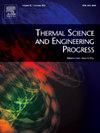新提出的太阳能热电厂布雷顿循环结构的熵分析
IF 5.1
3区 工程技术
Q2 ENERGY & FUELS
引用次数: 0
摘要
目前的工作是由两个总体目标驱动的。首先,将评估新颖创新的s-CO2布雷顿循环配置,包括带再压缩的部分冷却和主压缩机中间冷却- PCRCMCI、PCRCMCI- rh(带再热)和PCRCMCI- 2rh(带双再热)。与带再压缩- PCRC的部分冷却相比,后一种配置有望提高效率。其次,评估了三种CO2基混合物(CO2/C2H6、CO2/CH4和CO2/Kr)对新循环效率的影响。当混合物达到最佳效率时,与使用纯s-CO2作为工作流体相比,该值增加0.2至2.4个百分点。最有效的工质是含有s-CO2和乙烷,摩尔分数为0.30/0.70,对于PCRCMCI-2RH配置,效率值为51.3%。由s-CO2和甲烷组成的混合物(摩尔分数为0.70/0.30)是第二高效的,PCRCMCI-2RH构型的热效率为50.5%。最后对纯s-CO2和s-CO2混合物在两种拓扑结构(PCRCMCI和PCRCMCI- 2rh)下的火用效率进行了比较分析。研究结果表明,s-CO2混合物能够将火用效率提高5.6%。此外,还得出结论,优化传热特性和设计相应的设备有可能提高太阳能场基础设施的效率。这一发现表明,s-CO2混合物可能在下一代能源系统的发展中发挥关键作用。本文章由计算机程序翻译,如有差异,请以英文原文为准。
Entropy analysis of new proposed Brayton cycle configurations for solar thermal power plants
The present work is driven by two overarching objectives. Firstly, novel and innovative s-CO2 Brayton cycle configurations are to be evaluated, including Partial Cooling with Recompression and Main Compressor Intercooling−PCRCMCI, PCRCMCI-RH (with Reheat) and PCRCMCI-2RH (with Dual Reheat). The latter configurations are expected to increase efficiency compared to the Partial Cooling with Recompression−PCRC. Secondly, the impact of three CO2-based mixtures (CO2/C2H6, CO2/CH4, and CO2/Kr) on the efficiency of the proposed novel cycles is assessed. When the mixture attains optimal efficiency, this value increases between 0.2 and 2.4 percentage points compared to use pure s-CO2 as working fluid. The most efficient working fluid is found to be that comprising s-CO2 and ethane in a molar fraction of 0.30/0.70, with an efficiency value of 51.3 % for the PCRCMCI-2RH configuration. The mixture comprising s-CO2 and methane with a molar fraction of 0.70/0.30, was the second most efficient, with a thermal efficiency of 50.5 % for the PCRCMCI-2RH configuration. The study concluded with a comparative analysis of the exergy efficiency of pure s-CO2 and s-CO2 mixtures in two topologies (PCRCMCI and PCRCMCI-2RH). The findings of the study demonstrated that the s-CO2 mixtures exhibited the capacity to enhance exergy efficiency by up to 5.6 percent points. Furthermore, it was concluded that optimising heat transfer properties and designing equipment accordingly has the potential to enhance efficiency in solar field infrastructure. This finding suggests that s-CO2 mixtures could play a pivotal role in the development of next-generation energy systems.
求助全文
通过发布文献求助,成功后即可免费获取论文全文。
去求助
来源期刊

Thermal Science and Engineering Progress
Chemical Engineering-Fluid Flow and Transfer Processes
CiteScore
7.20
自引率
10.40%
发文量
327
审稿时长
41 days
期刊介绍:
Thermal Science and Engineering Progress (TSEP) publishes original, high-quality research articles that span activities ranging from fundamental scientific research and discussion of the more controversial thermodynamic theories, to developments in thermal engineering that are in many instances examples of the way scientists and engineers are addressing the challenges facing a growing population – smart cities and global warming – maximising thermodynamic efficiencies and minimising all heat losses. It is intended that these will be of current relevance and interest to industry, academia and other practitioners. It is evident that many specialised journals in thermal and, to some extent, in fluid disciplines tend to focus on topics that can be classified as fundamental in nature, or are ‘applied’ and near-market. Thermal Science and Engineering Progress will bridge the gap between these two areas, allowing authors to make an easy choice, should they or a journal editor feel that their papers are ‘out of scope’ when considering other journals. The range of topics covered by Thermal Science and Engineering Progress addresses the rapid rate of development being made in thermal transfer processes as they affect traditional fields, and important growth in the topical research areas of aerospace, thermal biological and medical systems, electronics and nano-technologies, renewable energy systems, food production (including agriculture), and the need to minimise man-made thermal impacts on climate change. Review articles on appropriate topics for TSEP are encouraged, although until TSEP is fully established, these will be limited in number. Before submitting such articles, please contact one of the Editors, or a member of the Editorial Advisory Board with an outline of your proposal and your expertise in the area of your review.
 求助内容:
求助内容: 应助结果提醒方式:
应助结果提醒方式:


